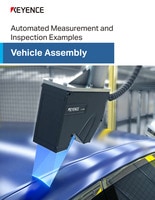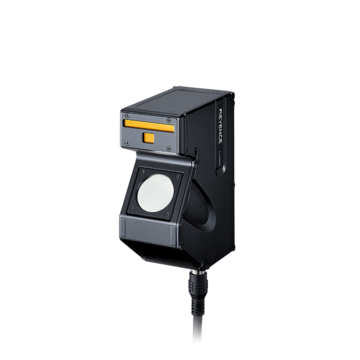Measurement Sensors
Dimension Measurement
Displacement Measurement
Welding Seam Inspection
Welding is a crucial part of numerous industries, from general construction to the automotive industry, aerospace, shipping and rail, and maintenance. Good welds help ensure structures and components can withstand significant loads and wear over long periods.
In order to achieve consistently good welds, manufacturers must produce reliable and defect-free welding seams. Defective seams compromise structural integrity, pose significant safety risks, and incur massive maintenance and repair costs.
Fortunately, modern 2D and 3D laser profilers can improve quality control associated with weld inspection thanks to their incredible precision and high-accuracy measurements.
Get detailed information on our products by downloading our catalog.
View Catalog

Challenges in Weld Seam Defect Detection
The welding process is inherently complex due to differences in techniques and materials. As a result, weld inspection is a challenging process and defects (e.g. weld pits inspection) are difficult to detect.
For example, the accessibility and visibility of certain weld seams might limit the effectiveness of a visual inspection. Any inspection which relies on the skill and experience of an operator makes it susceptible to human error.
Advantages of Automated Weld Seam Inspection Systems
Fortunately, automated weld seam inspection systems aren’t susceptible to human error and don’t typically suffer visibility issues, as they rely on various measurement sensors. These sensors, which are typically laser displacement sensors or laser profilers, are extremely reliable and very precise.
Increased Welding Efficiency and Accuracy
Thanks to their incredible accuracy and precision, which often measures in the single-digit µm range, automated weld seam inspection sensors reduce the variability caused by human error and thus provide significantly more consistent results.
Additionally, these sensors are often integrated into quality control and process control systems, which allows them to provide immediate feedback to process operators, enabling them to make quick adjustments and corrections to the welding process.
Cost Savings and Time Reduction
Relying on laser displacement sensors and laser profilers for weld seam inspection usually leads to considerable cost savings. For example, these sensors can inspect welds for pits and other defects much faster compared to manual methods, leading to higher production rates.
Additionally, these sensors can be used to discover defect patterns and indicate a maintenance issue. This can lead to better preventive maintenance and prevent costly rework and material waste.
Discover more about this product.
Click here to book your demo.

Seam Finding, Tracking, and Guiding as an Application
Seam finding/tracking is a crucial application in the welding industry as it ensures accurate and consistent weld positioning, which is essential for structural integrity and strength. Additionally, seam finding/tracking allows for precise control of the welding process, including speed and heat input, yielding high-quality welds. Automatic seam tracking, finding, and guiding also saves time and reduces the need for manual labor, thus increasing overall production efficiency.
KEYENCE’s LJ-X8000 Series laser profiler contains the technology and capabilities to excel in this application. Unlike traditional vision tracking systems, the LJ-X8000 Series relies on direct height data rather than part contrast, making it more reliable and accurate. It can capture the whole part with just one sensor, utilizing both 2D and 3D position tracking. This feature allows the LJ-X to account for variations in part presentation, ensuring consistent and precise results.
Quality Checking as an Application
Quality checking and bead appearance inspection are critical for ensuring weld integrity and meeting industry standards. Common weld failure points can result in costly rework or even safety hazards, making it essential to have accurate and reliable quality-checking methods.
Quality checking inspects the appearance of all weld beads, including dimensions such as throat thickness and leg length, undercuts, and blow holes. These measurements are crucial in verifying that the welding process is within the specified tolerances and meeting the required standards.
The LJ-X Series offers a highly efficient solution for quality checking through its automated inspection capabilities. By following the welding torch, it can inspect 100% of welding beads in real-time, providing immediate feedback on any defects like splatter, pits, slag or burn-through, or deviations from the desired dimensions. This allows for quick adjustments to be made and ensures that all welds meet the required standards.
One of the biggest advantages of using laser measurement technology like the LJ-X Series is its ability to measure directly without relying on part contrast. This eliminates potential errors caused by variations in part color or reflectivity, ensuring accurate and consistent measurements every time.
Comparison with Manual Seam Inspection Methods
As previously stated, the accuracy and reliability of manual weld inspection methods significantly depend on the measurement technique, the accuracy of the tools used in conducting measurements and seam inspection, and the skill and expertise of the operator or inspector conducting weld inspections for pits, cracks, spatter, and more.
Automated systems, on the other hand, rely upon various laser displacement sensors and laser profilers to scan the weld seam during weld inspection. The increased accuracy and machine precision of these instruments allow for easier and more reliable weld defect detection, with the added ability to control processes and record and analyze data over time. This analysis can provide additional insight into the welding process and potential improvements that can affect its effectiveness.
KEYENCE offers a comprehensive range of laser displacement sensors and laser profilers, along with complete machine vision systems for weld inspection. If you’re interested in upgrading your current setup, contact us today!
Contact us to learn more about how our advanced technology can help take your business to the next level.
Contact Us
Related Downloads

Learn a wide variety of topics about welding technology from welding types and mechanisms to robotic automation of welding. Detailed explanations are also given for the causes and phenomena of welding defects as well as measurement and inspection methods vital to welding quality management.
Related Products
Applications
Dimension Measurement
- Thickness and Width Measurement
- Step Height Measurement
- Inner and Outer Diameter Measurement
- Measuring Angles
- Meandering/Edge Measurement
Displacement Measurement
- Positioning and Stroke Length Measurement
- Vibration and Runout Measurement
- Deflection Measurement
- Measuring Eccentricity



